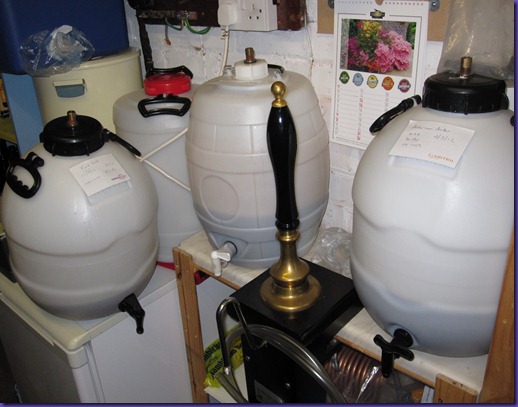I had some ex-work friends over on Thursday night. We usually go into Wilmslow for beer, curry and a chat once a month, but since I have three barrels of beer ready to drink in the garage, I suggested they come to me first for a sampling session.
So the poor guys ended up trapped in my garage whilst I babbled on about step infusion mashes and alpha acid isomerisation. They nodded with polite interest, but I am pleased to say that the beer was consumed with some enthusiasm. It’s fortunate that the by-product of my hobby is something most of my friends seem very happy to drink!
I have previously blogged about the making of all three of the beers we drank that night, but what I haven’t done is write some tasting notes now the beers are being drunk. So here we go.
First Gold Experiment
Many of our beers at the moment use just a single hop variety. We’re doing this because there is such a huge range of hops available these days, and we want to understand what they are like. I first heard about the First Gold variety through the Badger beer of the same name. It’s an English dwarf hop with huge versatility both for bittering and also for flavour and aroma.
We made a simple, pale ale and used plenty of First Gold hops. Initially it had a wonderful sweet, spicy and slightly citrus (for an English hop) aroma and good robust bitterness. Over the weeks this has eased off a lot, leaving a rich and balanced English ale. We’re very pleased with this variety and I’d certainly choose to use it again.
American Amber Ale
The recipe for this was based on a recipe in Brewing Classic Styles by Jamil Zainasheff. It has a fairly complex grain bill: pale ale malt, munich malt, two types of crystal malt and also biscuit malt. You can certainly get the orangey flavour of the munich malt in this rich and sweet amber ale. The hops are two US varieties: Centennial and Amarillo.
When we first tried this beer it was a strange beast. The aroma of the hops was very strident – quite a distinct flowery and citrus aroma. But the taste of the beer just didn’t match it. It was like drinking two different beers in the same glass. I worried that we’d cocked it up, but it is surprising what a number of weeks maturation can do. Gradually the strong hop aroma eased off enough for the beer to blend itself into a satisfyingly sweet ale. The colour of the head is curiously orange (probably that munich malt).
I think if we did it again I would try to make it a little less sweet, but other than that I’m very pleased with it.
The Guildford Ginger
This is probably the most experimental of the three. We devised the recipe by looking on a few internet forums, and then sticking a finger in the air.
The amount of ginger to use was our major concern – some people reported a few hundred grams; others over a kilogram! In the end we used 800g of very fresh grated ginger in the boil, and it was perfect. The beer has a robust ginger aroma and flavour without being too overpowering. There is also a slight kick at the back of the throat that stays with you for quite a while. You know you are drinking ginger, without it going too far. We’d happily brew this one again without any changes to the recipe.
